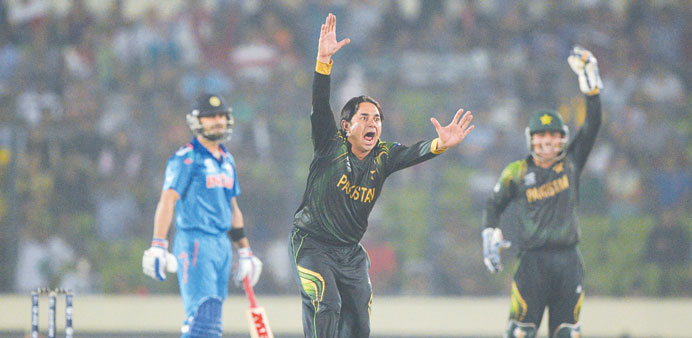Pakistan cricketer Saeed Ajmal (centre) unsuccessfully appeals for a leg before wicket decision against Indian cricketer Virat Kohli during the ICC World Twenty20 match at The Sher-e-Bangla National Cricket Stadium in Dhaka. (AFP)
Nick Miller, theguardian.com /London
Cricket is a batsman’s game. Its rules are, largely, designed to facilitate the scoring of runs. And rightly so you try hitting a ball with a circumference of nine inches with a slender bit of wood when it is flung in your direction at 90mph from 22 yards away.
In those circumstances, a batsman has roughly half a second to judge where the ball is going to pitch, if at all, decide whether to play a shot, select which shot to play, then actually play it. As Andy Bull wrote in the Spin, all of this requires a set of reactions that outstrips the standard comprehension of the human mind. Expecting a batsman to do all of this competently is basically unreasonable and that is why only a handful of humans can do it to any sort of standard.
It is hard, but as with all elite sport it is supposed to be hard. This is partly why many of the tweaks and alterations to the laws of the game have been made with batsmen in mind.
When Douglas Jardine, Harold Larwood and Bill Voce came up with the ‘leg theory’ plan to try to stop Don Bradman, fielding restrictions were brought in.
Batsmen are allowed to pull out of a shot if a rogue pigeon, plastic bag or MCC member raising a port glass catches their eye, even if the bowler is in his delivery stride. Bowlers are only allowed to deliver a certain number of bouncers per over.
And when Graeme Smith decided Steven Finn’s tick of hitting the stumps at the non-striker’s end with his leg was just too darn distracting and disturbed the batsman’s sensitive collective consciousness, the law was altered to make this a no ball.
This excuse was, of course, rendered rather redundant when in the second Test at Headingley in 2012, the game in which the issue came to a head, Smith smacked a couple of balls to the boundary after the stumps at the non-striker’s end had been broken.
Not overly distracting, then, but the law was still changed in the batsman’s favour. It is time then, to redress the balance and make life a little easier for bowlers. Reversing Finn’s Law would be a start, as would making the wide law a little more like baseball, specifically that if a player plays a shot, it cannot be classed as a wide.
However, a more significant alteration would be to change the part of the lbw law that states a batsman cannot be given out if the ball pitches outside leg stump.
Leg before wicket was introduced in the early days of the game because batsmen were simply blocking wicket-bound balls with their pads and has been tinkered with on many occasions down the years when circumstances have seen fit.
The leg-side provision was introduced for justifiable reasons primarily in order to discourage negative bowling at or even beyond the legs, but it offers an enormous advantage to the batsman in that if the ball pitches outside the leg-side line of the wicket, they can simply get their pads in the way, safe in the knowledge that they cannot be out. The very thing that the lbw law was designed to eliminate is still present, albeit in a watered-down form.
It seems incongruous that a leg-spinner can bowl a ripping turner that completely outfoxes their opponent, or a left-arm seamer beats a right-handed bat with a late swinger that is only prevented from crashing into the wickets by the batsman’s pads, only to be denied because the ball had landed an inch or so outside the line of leg stump.
At the very least, a batsman should be able to be dismissed if the ball strikes his pads while playing no shot, irrespective of where the ball pitched. At present that only applies if the batsman is struck outside the line of the stumps, an alteration made way back in 1957, but the protection of the leg stump section of the law makes it something of a half measure.
Of course, there are potential problems with such a change. There would be an increase in bowlers coming around the wicket and targeting the pads, given that this is basically a whole new way of getting someone out.
However, they would still need to be accurate and the balance of skill between batsman and bowler would remain.
It would also change the nature of batting to some extent because the different angle of attack would require them to alter their approach, but this is hardly the end of the world.
A shift to a leg-stump guard here, an opening of the stance there, and while there might be an initial spike in lbw decisions and some ticked-off batsmen who fear change (don’t we all), they would eventually adapt.
Although it may initially be more difficult to score runs, it may even encourage attacking play, in Tests at least. With things as they are, and bowlers generally taking an outside off-stump approach, a batsman will leave a decent proportion of deliveries to go through to the wicketkeeper. But if bowlers change their line of attack then this would be an altogether less frequent option.
Batsmen would be forced to use outlandish concepts like hitting the ball with the bat more. They will take a while to get used to it, but they will do it in the end.
The change would make life more difficult for batsmen but they have had things their way for so long, isn’t it time to throw bowlers a bone?
Do you agree? Or do you think batsmen already have a tough enough time without this spanner in their works as well? Let us know below the line.



